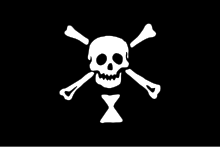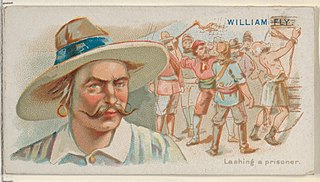
Emanuel Wynn [lower-alpha 1] (fl. 1700) was a French pirate of the 17th century who is often considered the first pirate to fly the Jolly Roger.

Emanuel Wynn [lower-alpha 1] (fl. 1700) was a French pirate of the 17th century who is often considered the first pirate to fly the Jolly Roger.
British Admiralty Records, in the Public Records Office in the UK show, in a report dated 18 July 1700, that HMS Poole, a 32-gun fifth-rate frigate [1] commanded by Captain John Cranby, engaged Wynn's ship off the Cape Verde islands. Cranby chased Wynn into a cove at Brava Island [lower-alpha 2] where Wynn was able to hold out. Cranby enlisted the assistance of Portuguese soldiers, but thanks to their delay in attacking, Wynn slipped out of the harbor and escaped. [2]
Most historians agree that Cranby's journal is the first witness account of a black Jolly Roger used aboard ship, [3] which Cranby described as "a sable ensign with cross bones, a death's head, and an hour glass" (the quotation is from Earle, Pirate Wars, p. 154) or "A Sable Flag with a White Death's Head and Crossed Bones in the Fly." [4] Wynne is believed to be the first pirate to fly the now familiar form of the jolly roger. [5] His flag, showing the distinctive skull and crossbones motif, was augmented with another common pirate symbol: an hourglass, meant to signify to his prey that their time was running out and only by timely surrender could they evade death. [6] There were no other reports at the time of pirates using similar flags aboard ship (though red and other versions had been used by buccaneers during campaigns while ashore) [7] but within 15 years the skull and crossbones design and its many variants would become the standard flag of Golden Age pirates. [8]

Jolly Roger is the traditional English name for the naval ensign flown to identify a pirate ship preceding or during an attack, during the early 18th century. The vast majority of such flags flew the motif of a human skull, or “Death's Head”, often accompanied by other elements, on a black, dark brown or dark blue field, sometimes called the “Death's Head flag” or just the “black flag”.

John Rackham, commonly known as Calico Jack, was an English pirate captain operating in the Bahamas and in Cuba during the early 18th century. His nickname was derived from the calico clothing that he wore, while Jack is a nickname for "John".
A skull and crossbones is a symbol consisting of a human skull and two long bones crossed together under or behind the skull. The design originated in the Late Middle Ages as a symbol of death and especially as a memento mori on tombstones.

Condent, born in Plymouth in Devon, was an English pirate who was best known for his piracies in the Indian Ocean.

Totenkopf is the German word for skull. The word is often used to denote a figurative, graphic or sculptural symbol, common in Western culture, consisting of the representation of a human skull- usually frontal, more rarely in profile with or without the mandible. In some cases, other human skeletal parts may be added, often including two crossed long bones (femurs) depicted below or behind the skull. The human skull is an internationally used symbol for death, the defiance of death, danger, or the dead, as well as piracy or toxicity.
Benjamin Hornigold (1680–1719) was an English pirate who operated during the tail end of the Golden Age of Piracy.

Libertatia was a purported pirate colony founded in the late 17th century in Madagascar under the leadership of Captain James Misson. The main source for Libertatia is Volume 2 of A General History of the Pyrates, a 1724 book which describes Captain Misson and Libertatia. Little to no corroborating evidence for Libertatia beyond this account has been found, however. Whether Libertatia was real but somehow "lost" to history, a pirate legend that the author recorded based on interviews with sailors, or a concocted work of utopian fiction by the author from the start is contested.

William Fly was an English pirate who raided New England shipping fleets for three months in 1726 until he was captured by the crew of a seized ship. He was hanged in Boston, Massachusetts and his body publicly exhibited as a warning to other pirates. His death is considered by many to mark the end of the Golden Age of Piracy.

The Golden Age of Piracy is a common designation for the period between the 1650s and the 1730s, when maritime piracy was a significant factor in the histories of the North Atlantic and Indian Oceans.

Edward "Ned" Low was a notorious pirate of English origin during the latter days of the Golden Age of Piracy, in the early 18th century. Low was born into poverty in Westminster, London, and was a thief from an early age. He moved to Boston, Massachusetts, as a young man. His wife died in childbirth in late 1719. Two years later, he became a pirate, operating off the coasts of New England and the Azores, and in the Caribbean.

Often called bloody flags or the bloody red, pattern-free red flags were the traditional nautical symbol in European waters prior to the invention of flag signal codes to signify an intention to give battle and that 'no quarter would be given', indicating that surrender would not be accepted and all prisoners killed, but also vice versa, meaning that the one flying the flag would fight to the last man. Such flags were traditionally plain but examples with motifs also existed, such as skull and crossbones on some pirate examples.

A General History of the Robberies and Murders of the most notorious Pyrates, or simply A General History of the Pyrates is a 1724 book published in Britain containing biographies of contemporary pirates, which was influential in shaping popular conceptions of pirates. Its author uses the name Captain Charles Johnson, generally considered a pen name for one of London's writer-publishers. The prime source for the biographies of many well-known pirates, the book gives an almost mythical status to the more colourful characters, and it is likely that the author used considerable artistic license in his accounts of pirate conversations. The book also contains the name of Jolly Roger, the pirate flag, and shows the skull and crossbones design.
Christopher Moody (1650s-1722) was a pirate as a member of Bartholomew Roberts' crew but was never a captain in his own right. He is best known not for his own actions but for a popular Jolly Roger flag mis-attributed to him as well as for later authors confusing him with unrelated pirate William Moody.
See also 1699 in piracy, 1701 in piracy, and Timeline of piracy.
Charles Harris (1698-1723) was an English pirate active in the 1720s. He is best known for his association with George Lowther and Edward Low.
Skull and crossbones variations have been used by several military forces. The "Jolly Roger", traditionally used by pirates, has been used by submarines.

John Phillips was an English pirate captain. He started his piratical career in 1721 under Thomas Anstis, and stole his own pirate vessel in 1723. He died in a surprise attack by his own prisoners. He is noted for the articles of his ship, the Revenge, one of only a few complete sets of pirate articles to survive from the so-called Golden Age of Piracy.

The Republic of Pirates was the base and stronghold of a loose confederacy run by privateers-turned-pirates in Nassau on New Providence island in the Bahamas during the Golden Age of Piracy for about twelve years from 1706 until 1718. While it was not a republic in a formal sense, it was governed by an informal pirate code, which dictated that the crews of the Republic would vote on the leadership of their ships and treat other pirate crews with civility. The term comes from Colin Woodard's book of the same name.

The Jolly Roger is a symbol that has been used by submarines, primarily those of the Royal Navy Submarine Service and its predecessors. The practice came about during World War I: remembering comments by First Sea Lord Admiral Sir Arthur Wilson, who complained that submarines were "underhanded, unfair, and damned un-English" and that personnel should be hanged as pirates, Lieutenant Commander Max Horton began flying the flag after returning from successful patrols. Initially, Horton's submarine HMS E9 flew an additional flag after each successful patrol, but when there was no room for more, the practice was changed to a single large flag, onto which symbols indicating the submarine's achievements were sewn.